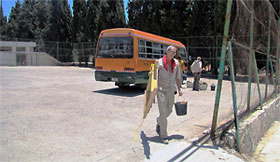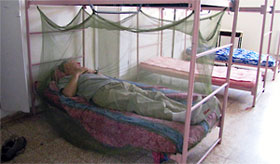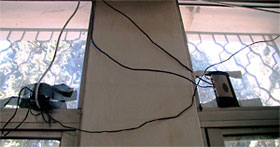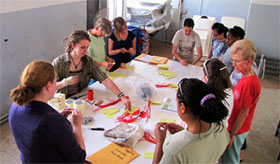Weekly Reports from Jordan
Choose Year: or Choose week
Camp Life
John McDowell
 Our base, as it has been for 10 seasons (20 years), is the Amman Training Centre in Muqabalayn —a school for Palestinian refugees that offers courses leading to two-year diplomas in Business, Hair Dressing, and Information Technology. The school also offers four-year BA degrees in Teacher Training (Elementary), Arabic, and English language study. This last
Our base, as it has been for 10 seasons (20 years), is the Amman Training Centre in Muqabalayn —a school for Palestinian refugees that offers courses leading to two-year diplomas in Business, Hair Dressing, and Information Technology. The school also offers four-year BA degrees in Teacher Training (Elementary), Arabic, and English language study. This last  year they had 210 diploma program graduates and 203 BA graduates. All involved with the school are welcoming and, in truth, make our stay as pleasant as possible.
year they had 210 diploma program graduates and 203 BA graduates. All involved with the school are welcoming and, in truth, make our stay as pleasant as possible.
Arriving early at the Amman Training Centre, some of us enjoyed the privilege of carrying crates down three flights of stairs, hauling out and fumigating mattresses, sorting trowels and tags, or helping to build an outhouse.
 Once one arrives, there are adjustments to be made—such as navigating the facilities.
Once one arrives, there are adjustments to be made—such as navigating the facilities.  There are two dorms—one for women and one for men. No surprise, but the women’s dorm rooms tend to be neater than the men’s.
There are two dorms—one for women and one for men. No surprise, but the women’s dorm rooms tend to be neater than the men’s.
 A typical day begins with Doug Clark playing The Call to Dig bell chorus at 4:15 am. (That is, if you have not already awoken to the calls to prayer beginning around 3:30 am from one of the many mosques within hearing range. You quickly adjust and find that some are melodious and beautiful.) After a quick breakfast, the busses leave promptly for the ten minute ride to the dig site—Tall al ‘Umayri.
A typical day begins with Doug Clark playing The Call to Dig bell chorus at 4:15 am. (That is, if you have not already awoken to the calls to prayer beginning around 3:30 am from one of the many mosques within hearing range. You quickly adjust and find that some are melodious and beautiful.) After a quick breakfast, the busses leave promptly for the ten minute ride to the dig site—Tall al ‘Umayri.

 After a full morning digging and sifting dirt (subject of a future photo essay), the busses arrive back at camp just after 12:30. There is just enough time for a quick shower.
After a full morning digging and sifting dirt (subject of a future photo essay), the busses arrive back at camp just after 12:30. There is just enough time for a quick shower.

 Lunch is at 1:oo pm—this year the food is well prepared with a variety of dishes—including options for both vegetations and carnivores. Birthdays and national holidays are celebrated with a special desert—such as Canada Day with a Canada flag cake—although the maple leaf had a remarkable resemblance to a grape leaf! Lunch is also time for announcements, especially about finds of the day.
Lunch is at 1:oo pm—this year the food is well prepared with a variety of dishes—including options for both vegetations and carnivores. Birthdays and national holidays are celebrated with a special desert—such as Canada Day with a Canada flag cake—although the maple leaf had a remarkable resemblance to a grape leaf! Lunch is also time for announcements, especially about finds of the day.


 After lunch there is a designated, “quiet time.” You may sleep, read, draw, do laundry, catch up on e-mail or once a week change your dollars into dinars. (A word here about computers—it appears to be a vital necessity for most everyone. When the system goes down, many don’t know what to do with themselves.) Here is part of our very sophisticated network set-up.
After lunch there is a designated, “quiet time.” You may sleep, read, draw, do laundry, catch up on e-mail or once a week change your dollars into dinars. (A word here about computers—it appears to be a vital necessity for most everyone. When the system goes down, many don’t know what to do with themselves.) Here is part of our very sophisticated network set-up.

 Pottery washing begins at 4 (often before)—one of the most anticipated and enjoyed of camp chores. At four there is also pottery reading—an analysis of the previous day’s haul.
Pottery washing begins at 4 (often before)—one of the most anticipated and enjoyed of camp chores. At four there is also pottery reading—an analysis of the previous day’s haul.
 Once washing and reading of pottery are complete—some go down town, others fly to their computers to do
Once washing and reading of pottery are complete—some go down town, others fly to their computers to do  e-mail and check the World Cup scores. Artifacts and objects are photographed. Suha Huffaker is in charge of numbering and cataloging all artifacts and objects. Gary Huffaker, our medical doctor in residence, will care for aliments or injuries.
e-mail and check the World Cup scores. Artifacts and objects are photographed. Suha Huffaker is in charge of numbering and cataloging all artifacts and objects. Gary Huffaker, our medical doctor in residence, will care for aliments or injuries.  Most evenings there is a lecture from one of the many resident experts. On Monday nights we are privileged to have Hussam Shahroor, the Administrative Director of ATC and a La Sierra University MBA graduate, give us elementary Arabic lessons.
Most evenings there is a lecture from one of the many resident experts. On Monday nights we are privileged to have Hussam Shahroor, the Administrative Director of ATC and a La Sierra University MBA graduate, give us elementary Arabic lessons.
 At the end of the day, people often sit outside in the cooling evening and read. If you are very lucky you might be favored with a glimpse of the fox that lives in the field behind the dorms [Fig. 22 Fox]. Soon, however, people are off to bed—again often with the sound of the call to prayer:
At the end of the day, people often sit outside in the cooling evening and read. If you are very lucky you might be favored with a glimpse of the fox that lives in the field behind the dorms [Fig. 22 Fox]. Soon, however, people are off to bed—again often with the sound of the call to prayer:
Ash-hadu al-la Ilaha ill Allah - Ash-hadu al-la Ilaha ill Allah
(Allah is Great, Allah is Great)
Ash-hadu anna Muhammadan Rasulullah
(I bear witness that there is no divinity but Allah)
Ash-hadu anna Muhammadan Rasulullah.
(I bear witness that Muhammad is Allah's Messenger)
Hayya la-s-saleah - Hayya la-s-saleah
(Hasten to the prayer, Hasten to the prayer)
Hayya la-l-faleah - Hayya la-l-faleah
(Hasten to real success, Hasten to real success,)
Allahu Akbar, Allahu Akbar
(Allah is Great, Allah is Great)
La Ilaha ill Allah
(There is no divinity but Allah)
Archaeological Report
 Though the dust has barely settled from pounding in the corner stakes and tying on “balk string” to mark out this year’s excavation squares, already this week we are beginning to see the results of the full week of digging. Field A, supervised by Stephanie Brown, has begun excavating down through the tumbled burned mud-bricks and charred beams of an early Iron Age house from about 1200 BC (time of the biblical Judges).
Though the dust has barely settled from pounding in the corner stakes and tying on “balk string” to mark out this year’s excavation squares, already this week we are beginning to see the results of the full week of digging. Field A, supervised by Stephanie Brown, has begun excavating down through the tumbled burned mud-bricks and charred beams of an early Iron Age house from about 1200 BC (time of the biblical Judges).  This building is adjacent to and contemporary with two other houses excavated in previous seasons that contained the smashed remains of nearly 100 large store jars along with other household items and even human skeletal remains. Excavators Audrey Shaffer and Sashiere Stewart this week uncovered parts of a store jar similar to those in the neighboring houses. We think more vessels may lie on the floor of the room. In another part of the room, the sharp eyes of Vera Kopecky in the excavation square supervised by Nicole Castanon found several small items including a very fine spindle whorl possibly for spinning linen. In the final hour of the week, Ken Crane, Michaela Herbert and Aran McDowell found what must be the south wall of this building. Further excavation will help us understand the floor-plan better.
This building is adjacent to and contemporary with two other houses excavated in previous seasons that contained the smashed remains of nearly 100 large store jars along with other household items and even human skeletal remains. Excavators Audrey Shaffer and Sashiere Stewart this week uncovered parts of a store jar similar to those in the neighboring houses. We think more vessels may lie on the floor of the room. In another part of the room, the sharp eyes of Vera Kopecky in the excavation square supervised by Nicole Castanon found several small items including a very fine spindle whorl possibly for spinning linen. In the final hour of the week, Ken Crane, Michaela Herbert and Aran McDowell found what must be the south wall of this building. Further excavation will help us understand the floor-plan better.
 A different kind of progress is occurring in Field H where field director Monique Vincent is overseeing the disassembly and removal of a great stone wall constructed of large limestone boulders. Our hired workmen pried loose the stones and broke them with sledge hammers into manageable sizes for carrying away. We carefully mapped and drew the wall and must now remove it to achieve the research goals of the expedition for this area. A courtyard sanctuary was constructed in this part of the ancient town during the 11th century BC. Previous seasons of excavation clarified how this sanctuary was expanded and modified until it was finally abandoned. Now we want to discover what was here at a lower, earlier level. As part of this project, team members in other areas of Field H, Gary Huffaker, Canty Wang, Ruth Kent, Jillian Logee, Larry Murrin, Matthew “Hew” Murdoch, and Carolyn Waldron were busy excavating into debris contemporary with the early Iron Age houses found in Fields A and B. The buildings from that ti
A different kind of progress is occurring in Field H where field director Monique Vincent is overseeing the disassembly and removal of a great stone wall constructed of large limestone boulders. Our hired workmen pried loose the stones and broke them with sledge hammers into manageable sizes for carrying away. We carefully mapped and drew the wall and must now remove it to achieve the research goals of the expedition for this area. A courtyard sanctuary was constructed in this part of the ancient town during the 11th century BC. Previous seasons of excavation clarified how this sanctuary was expanded and modified until it was finally abandoned. Now we want to discover what was here at a lower, earlier level. As part of this project, team members in other areas of Field H, Gary Huffaker, Canty Wang, Ruth Kent, Jillian Logee, Larry Murrin, Matthew “Hew” Murdoch, and Carolyn Waldron were busy excavating into debris contemporary with the early Iron Age houses found in Fields A and B. The buildings from that ti me period are particularly well preserved at ‘Umaryi, which is one of the best examples anywhere in Jordan or Israel of houses from this pivotal time, and we are curious to discover what might be revealed here this week or next.
me period are particularly well preserved at ‘Umaryi, which is one of the best examples anywhere in Jordan or Israel of houses from this pivotal time, and we are curious to discover what might be revealed here this week or next.
 Veterans David Hopkins and Mary Boyd are completing studies on a Hellenistic period farmstead which they excavated in past seasons in Field L, an area now being expanded and directed by Carrie Duncan. While removing an excavation balk, the sections left standing for stratigraphic control in the grid of excavation squares, Mary found the head of a female figurine. She pointed out to us its happy smile and coifed hair. Square supervisors Nikki Oakden and Stephanie McIntosh along with Olivia Jensen , Justin Waring-Crane, and John McDowell (when he’s not serving in his other role as expedition photographer) are digging through topsoil as they open two new squares for study. Topsoil contains a higher number of pottery sherds and small artifacts concentrated by the winnowing of centuries of winds and rains. On Friday, Carrie found a seal impression in clay depicting some sort of bird-like creature.
Veterans David Hopkins and Mary Boyd are completing studies on a Hellenistic period farmstead which they excavated in past seasons in Field L, an area now being expanded and directed by Carrie Duncan. While removing an excavation balk, the sections left standing for stratigraphic control in the grid of excavation squares, Mary found the head of a female figurine. She pointed out to us its happy smile and coifed hair. Square supervisors Nikki Oakden and Stephanie McIntosh along with Olivia Jensen , Justin Waring-Crane, and John McDowell (when he’s not serving in his other role as expedition photographer) are digging through topsoil as they open two new squares for study. Topsoil contains a higher number of pottery sherds and small artifacts concentrated by the winnowing of centuries of winds and rains. On Friday, Carrie found a seal impression in clay depicting some sort of bird-like creature.
Our fourth field is directed this year by Lizzie Brown. Field M which was new last season, has the challenge of just that—being quite new. This means we don’t yet know much about the walls and pavements which are taking shape before the relentless trowels of Rainbow Ford, Rebecca Waring-Crane, Anita Burns, Graeme Waring-Crane, and Stephanie Griffin. However, following the removal this week of two balks separating areas excavated last season, we now understand more about what appears to be a building from about the 8th century BC (time of Amos). They will continue to uncover more of this building next week.
Overheard
Ruth Kent about the lecture on the scintillating topic of research design delivered by Doug Clark:
When you lecture on research design,You must have at least one funny line.If you start to get boring,Everyone will be snoringAnd ignore your design so divine.
Justin Waring-Crane to GPS guru Matt Vincent:
“So, what’s it like to have a day-long break?”



